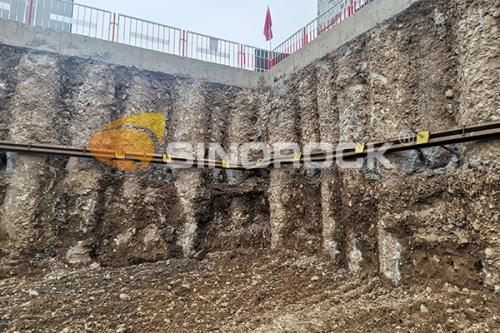Application of Self-drilling Soil Nail Retaining Wall in Protection of High Slope in Loess Soil

At present, new reinforcement technologies such as rock anchors that utilize the self-stabilizing ability of the stratum have been greatly developed. The safety protection of high slopes in collapsible loess and sand egg strata has always been a difficult problem for traditional reinforcement technologies and techniques. In the engineering practice of Luomen Station, the use of self-drilling bolt retaining wall has overcome this difficulty.
Self-drilling soil nail retaining wall mainly integrates the working principles of prestressed anchor cable retaining wall, soil nailing wall, conventional bolt retaining wall, high-pressure grouting anchoring technology and new material of self-drilling bolt. On the frame retaining wall, the other end is anchored in the stable rock mass within the sliding surface, and the rock-soil anchoring system is formed by the joint action of bolts, shotcrete and reinforced concrete frame retaining wall to generate bearing capacity. The bolt produces a compressive stress zone within a certain anchoring range, changing the passive protection of the traditional support structure into an active protection that fully utilizes the self-stabilizing ability of the rock mass itself, effectively controls the displacement of the rock mass, and destroys the thrust with the slope outward. With the increase of , the supporting force increases until it exceeds the limit equilibrium and is destroyed, and the supporting force gradually decays with the pull-out of the anchor rod, forming a flexible supporting force.
Self-drilling soil nail are hollow threaded bolts made of non-ordinary steel. The bolts are used as drill pipes and are equipped with disposable wear-resistant alloy steel drill bits. The drill pipe and the bolt are combined into one. Self-drilling bolts have the characteristics of high tensile, flexural, shear and surface bonding strength. The hollow of the bolt is used as the grouting channel, so that the grout can be filled in a ring form from the bottom of the hole to the orifice, which ensures that the annular space and the geotechnical space are filled fully, and there is no need to use casing for the formation with easily collapsed holes. Drilling, putting rods, grouting and anchoring can be completed at one time to improve efficiency. The thread of the self-drilling bolt is continuous and has the characteristics of extended connection, which is convenient for use in difficult environments and has a wide range of adaptability. The self-drilling bolt can be used for grouting while drilling in the soft soil layer or in the stratum where the hole wall needs to be reinforced. Combined with increasing the grouting pressure, the grouting in the hole can be filled, and the final formed column can reach the diameter of the drill bit. 1.5~2.5 times, making the rod body, cement slurry and formation tightly combined, firm and reliable.
Drilling + Grouting
Wet drilling method is adopted for drilling, the water is replaced by pure cement slurry with a water-cement ratio of 0.7~0.8, and the pressure of the cement slurry is controlled at 0.5~2MPa. The cement slurry can play a cementing role to cement the non-clay soil together. Through the precession of the bolt, the cement slurry is radiated into the soil layer from the grouting of the drill bit, and the cemented soil layer is smashed into pieces by the drill bit and squeezed into the hole. The wall plays the role of strengthening the hole wall, so as not to collapse the hole. The pressure grouting makes the cement mortar penetrate into the rock fissures, which increases the friction force and the gripping force between the grouting body and the stratum, thereby greatly improving the pullout resistance of the bolt. When the grouting pressure increases and reaches a certain value, the grouting and rotation are stopped.
Anchoring
After the concrete strength of the frame retaining wall meets the design requirements, adjust the position of the anchor rod, put on the backing plate and lock the nut, and immediately seal the free section of the anchor rod after tightening it. rod without bending the anchor rod.
Self-drilling soil nail retaining walls are used in the protection of high slopes in collapsible loess and sandy egg strata, which can greatly reduce the amount of engineering, overcome the difficulty of forming holes in the stratum, greatly improve work efficiency and save engineering investment.
Advertise on APSense
This advertising space is available.
Post Your Ad Here
Post Your Ad Here
Comments